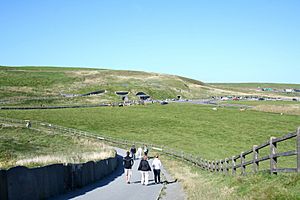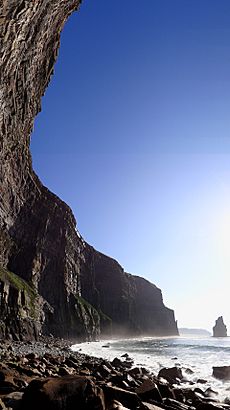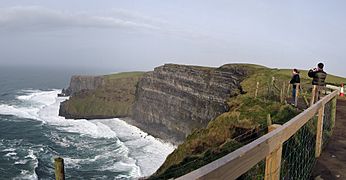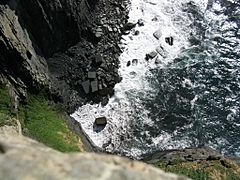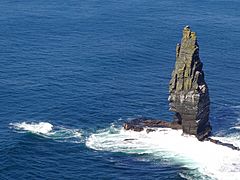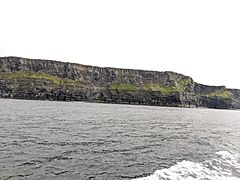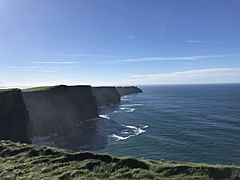Cliffs of Moher facts for kids
Quick facts for kids Cliffs of Moher |
|
|---|---|
| Native name Irish: Aillte an Mhothair |
|
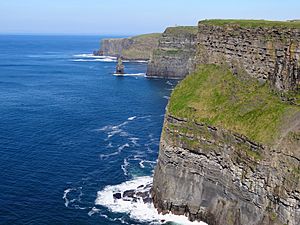
Looking north towards O'Brien's Tower
|
|
| Nearest city | Lahinch, County Clare, Ireland |
| Elevation | 155 m (509 ft) |
| Owner | Clare County Council, private farmers |
| Lua error in Module:Location_map at line 420: attempt to index field 'wikibase' (a nil value). | |
The Cliffs of Moher are amazing sea cliffs in County Clare, Ireland. They stretch for about 14 kilometers (9 miles) along the coast. At their lowest point, they rise 120 meters (390 feet) above the Atlantic Ocean. Further north, they reach their highest point of 214 meters (702 feet). This tall section is near O'Brien's Tower.
O'Brien's Tower is a round stone tower built in 1835 by Sir Cornelius O'Brien. From the cliffs and the tower, you can see the Aran Islands and mountains like the Maumturks and Twelve Pins. The Cliffs of Moher are one of Ireland's most popular tourist spots, with over a million visitors each year.
Contents
What's in a Name?
The cliffs get their name from an old fort called Mothar or Moher. This fort used to stand on Hag's Head, which is the southernmost part of the cliffs. Today, the Moher Tower is on that spot. The old fort was taken down in 1808. Its stones were used to build a lookout tower. This new tower was meant to warn people if French invaders were coming.
Visiting the Cliffs
The Cliffs of Moher are a huge draw for tourists in Ireland. They are part of the Burren and Cliffs of Moher Geopark. This Geopark is recognized by UNESCO for its special geology and nature. The cliffs are also a "signature point" on the Wild Atlantic Way, a famous tourist route.
You can walk along the cliffs for 18 kilometers (11 miles). Most visitors go to the official visitor center.
The Visitor Center
The Cliffs of Moher Visitor Experience is a modern center built right into a hillside. It was designed to be kind to the environment. It uses special systems like geothermal heating, solar panels, and water recycling.
This center opened in 2007. Inside, you can find interactive displays about the cliffs' geology, history, plants, and animals. There's also a big screen showing a bird's-eye view of the cliffs. You can even see videos from the underwater caves below! The center also has cafés and shops.
The visitor center has become very popular. Sometimes, it gets very busy, especially during peak season. To help with this, visitors are encouraged to come at quieter times.
Awards and Recognition
The Cliffs of Moher Visitor Experience won an award in 2007. Judges said the entire visitor center was "one of the best facilities that the judges had ever seen."
Viewing the Cliffs
There's an official walking path called the Cliffs of Moher Coastal Walk. It goes for 18 kilometers from Hag's Head to Doolin. This path passes the Visitor Center and O'Brien's Tower.
For safety, the official path is set back from the cliff edge. There used to be an unofficial path closer to the edge, but it was closed because of falling rocks. Visitors are always warned to stay on the safe, official path.
You can also see the cliffs from the sea! Many ferry trips take tourists below the cliffs. Sometimes, small planes from Connemara Airport offer views from above.
Geology and Wildlife
The Cliffs of Moher are made mostly of layers of rock called shale and sandstone. The oldest rocks are at the bottom. These rocks formed between 313 and 326 million years ago. Back then, a river carried sand and mud into an ancient ocean. Over millions of years, these layers hardened into the rocks we see today.
The cliffs are always changing because of ocean waves. The waves wear away the base of the cliffs, causing parts to fall. This creates cool shapes like sea caves and sea stacks. A sea stack is a tall rock column that was once part of the cliff. Branaunmore is a 67-meter (220-foot) tall sea stack near O'Brien's Tower. There are also many sea arches, which are natural rock bridges.
Animals and Birds
The Cliffs of Moher are home to many animals. About 30,000 pairs of birds live on the cliffs during peak season. There are more than 20 different bird species! These include cute Atlantic puffins and razorbills. The area is so important for birds that it's called an Important Bird Area.
In the waters below, you might spot grey seals, porpoises, dolphins, and even large minke whales and basking sharks. On land, you can find wild goats, foxes, badgers, and the Irish hare.
Getting There
You can reach the Cliffs of Moher by bus. Bus Éireann route 350 connects the cliffs to towns like Ennis, Doolin, and Galway. There's also a private shuttle bus from Doolin.
Gallery
See also
 In Spanish: Acantilados de Moher para niños
In Spanish: Acantilados de Moher para niños
- Wild Atlantic Way, a famous Irish tourist route.
- Slieve League, another place in Ireland with tall sea cliffs.
- Croaghaun, another Irish mountain with sea cliffs.
- Surfing in Ireland, Aileens is a famous big wave spot.
- List of tourist attractions in Ireland



